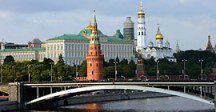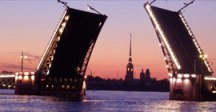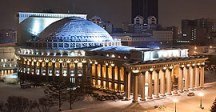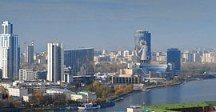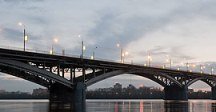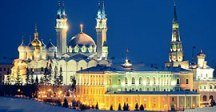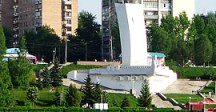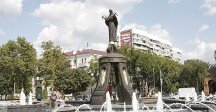Map of Kazan
Detailed interactive map of Kazan. Map of Kazan with streets and numbers of houses. Satellite map of Kazan with sights of the city.
The change between the satellite map of Kazan and the schematic one is made in the lower left corner of the interactive map.
Kazan
Population of the city Kazan: 1,257,341 people (2021)
Date of foundation of Kazan: 1005.
Kazan city phone code: +7 843
Automobile code of the city Kazan: 16, 116, 716
Postal code of the city Kazan: 420xxx
Kazan is the capital of Tatarstan. It is a large city on the territory of Russia, which is home to more than a million people. The most numerous ethnic groups of the city are Russians and Tatars. Unofficially, Kazan is called the third capital of Russia. The city is located just north of the Samara reservoir on the Volga, where the Kazanka River adjoins it.
The history of Kazan
Ancient Kazan was founded at the end of the 13th century by the Mongols (Tatars) of the Golden Horde after they overthrew the Bulgarian kingdom on the Middle Volga. It was located about 45 km upstream of the Kazanka River and was moved to the mouth of the river at the end of the 14th century. After the collapse of the Golden Horde in the 15th century, Kazan became the capital of the independent khanate.
The city developed as an important trade center; annual fairs were held on an island in the Volga. With the discovery of Siberia, Kazan's commercial importance increased significantly, and industry developed in the 18th century. By 1900, Kazan had become one of the main industrial cities in Russia.
Economy of Kazan
Soap making, tanning, shoemaking and fur manufacturing are still flourishing from the old industries. New industries include oil refining, electrical and precision engineering, and chemical manufacturing. Bed linen and food are also produced.
Education in Kazan
Kazan is a large cultural and educational center. Kazan State University was founded in 1804. Mathematician N.I. Lobachevsky was its rector in 1827-1846, and among those who studied there were Leo Tolstoy and composer M. A. Balakirev. Kazan also has a branch of the Academy of Sciences, a conservatory and other higher educational institutions. Kazan has a Tatar opera and ballet theater, a philharmonic hall, and the famous Tatar museum.
The city Kazan
Kazan is especially famous for its Orthodox buildings, the architecture of which is dominated by Muslim motifs. The Annunciation Cathedral, the Church of the Miraculous Image of the Savior, the Church of St. Nicholas the Soldier are just some of them.
Each of these buildings is unique in its own way and is a reflection of Russian architecture. Since there are many Tatars living in Kazan, you can see many mosques in the city. The main one is the Kul Sharif Mosque.
In addition to churches and cathedrals, there are historical buildings in the city. The main one is the Kazan Kremlin, which in ancient times served as a medieval defensive fortress. No less significant is such a symbolic structure as the Syuyumbike Tower. It serves as the main decoration of the city, without which Kazan can only be compared to Paris without the Eiffel Tower.
What to see in Kazan
The Epiphany Cathedral on Bauman Street was built in 1741 and subsequently
expanded in 1756.
Monument to Fyodor Chaliapin. The world-famous Russian opera singer Fyodor
Chaliapin was born in Kazan in 1873 and lived there until the age of 17, having
received his first experience of public singing in the city's church choir. This
monument was opened in 1999 to mark the 125th anniversary of Chaliapin's birth.
Gabulla Tukai Square. There is a statue of Gabdulla Tukai, who is one of the most famous Tatar poets and is considered the founder of modern Tatar literature. Tukai was born in Kazan province in 1886 and died in Kazan shortly before his 27th birthday in 1913. Tukai is buried at the Tatar cemetery in the south of Kazan.
St. John the Baptist Monastery was founded by St. Herman, Bishop of Kazan, sometime between 1564 and 1568 and dedicated to St. John the Baptist (known as John the Baptist).
Monument to Mullanur Vakhitov. There is a statue of the Tatar revolutionary Mullanur Vakhitov at the top of the hill on Tukai Square. Vakhitov was born in Perm province in 1885 and became interested in the social democratic movement in college. Later, he took part in the 1905 revolution in Kazan and became a member of the Bolshevik Party.
The Museum of Soviet Life on Universitetskaya Street was opened in 2011 after an exhibition entitled "Jeans as a Cult" proved popular in the city. The city authorities have allocated a former communal apartment to house a museum; a suitable place for such a museum.
Currently, the museum has various exhibits recreating everyday life in the Soviet Union in the 1970s and 1980s. Special attention is paid to Soviet schools, the Soviet army, music of that period (both Soviet and Western), and socialist art.
The Diocesan Cathedral of St. Nicholas the Wonderworker is better described as an architectural complex consisting of three buildings: a bell tower and two churches.
Until 1930, Bauman Street was known as Prolomnaya Street, because, according to local legend, it was here that Russian troops broke through the defenses of the city. Many of Kazan's attractions are located nearby, but the street itself also attracts attention with statues, fountains and other decorations. One of these statues is the carriage of Catherine the Great, which is an exact replica of the life-size carriage presented to the city by Catherine.
Monument to Gabriel Derzhavin. In the park near Gorky Street, known as Lyadsky Garden, there is a monument to the Russian poet and statesman Gabriel Derzhavin. Derzhavin was born in Kazan province and was a descendant of a Tatar prince who left the Golden Horde to serve Grand Duke Vasily II. In 1802, Derzhavin became the first Minister of Justice of the Russian Empire. This statue was unveiled in 2003, but is a reproduction of a statue that stood in Kazan from 1846 to 1932.
The Church of the Great Martyr Barbara on Karl Marx Street was originally built at the end of the 18th century to meet the needs of the local cemetery, but later it became an independent parish church.
The Maxim Gorky Literary Memorial Museum was opened in 1940 in the former house where Alexey Peshkov worked as a cook from 1886 to 1887, before taking the pseudonym Maxim Gorky and becoming a famous writer. Peshkov came to Kazan to enroll in Kazan Imperial University, but when it became impossible, he took up manual labor in the city. The museum presents exhibitions dedicated to Gorky and his family, as well as Fyodor Chaliapin.
The Kazan Millennium Museum was opened in 2005 as part of the celebration of the Millennium of Kazan at the Kazan National Cultural Center. The modern museum consists of three sections, the first of which is dedicated to ancient Kazan and Volga Bulgaria, the second to Kazan as part of the Russian Empire and the third to Kazan in Soviet times and the modern era. Each section contains a range of documents, drawings and photographs, as well as specially commissioned models and works of art.
The majestic and rather extravagant Palace of Farmers was built between 2008 and 2010 as the headquarters of the Ministry of Agriculture and Food Production. It is located on Feodoseevskaya Street, which begins near the beginning of Bolshaya Krasnaya Street and runs parallel to the Kazanka River. The palace was built amid some controversy due to its proximity to the UNESCO-protected Kremlin, but nevertheless it has since become one of the most famous modern attractions in Kazan.
St. Catherine's Lutheran Church on Karl Marx Street. Since the 16th century, there has been a Lutheran community in Kazan, mainly German immigrants. The construction of the first Lutheran church began after Catherine the Great's visit to Kazan in 1767 and was consecrated in 1771 in honor of St. Catherine. The current version was built between 1862 and 1865 in a romantic style.
The White Church of St. Parascheva Friday was built in the early 18th century to serve as a place of worship for a local textile factory. The church is also known as the Church of the Nativity of the Virgin Mary.
The State Museum of Fine Arts of the Republic of Tatarstan is located in the former Sandetsky estate, built in the early 19th century. The gallery has several collections, including ancient, classical and modern Russian art, Western and Oriental art, decorative and applied art, graphics and sculpture.
Vasily Aksenov House Museum. Opposite the State Museum of Fine Arts is the Vasily Aksenov House Museum. The Russian writer, best known for his saga "Generations of Winter", was born in Kazan in 1932. After his death in 2009, the house where he spent his childhood was turned into a museum, which tells in detail about his life and work.
Freedom Square. In a small park on Freedom Square, opposite the State Academic Opera and Ballet Theater, there is a statue of Vladimir Lenin. Lenin lived in Kazan from September 1888 to May 1889 and studied briefly at Kazan University until he was expelled for political activities. The building behind Lenin is the State Council of the Republic of Tatarstan.
The house-museum of Evgeny Boratynsky. In 1977, the Yevgeny Boratynsky Museum was opened in the school building and in the Boratynsky town estate. Boratynsky was a poet of the same era as Alexander Pushkin, who called Boratynsky the best elegiac poet in Russia. Boratynsky did not live in Kazan for long, as his wife had an estate nearby.
The Kazan Kremlin is located in the center of Kazan on a high peninsula jutting into the Kazanka and Volga rivers. The fortress has been located on this site since ancient times, but the current Kremlin was built by order of Tsar Ivan the Terrible after his conquest of Kazan in 1552. Pskov master architects were involved in the construction of 1800 meters of walls and 13 towers. Today, the Kremlin is the heart of Kazan and its most famous landmark. In 2000, it was included in the UNESCO World Heritage List.
Not far from the Kremlin, on the other side of the square of the First of May, there is the National Museum of the Republic of Tatarstan, which is located in a beautiful old building. The museum has been located here since 1895 and is based on the collection of local historian Andrei Likhachev. Now the museum serves as an advanced museum of Tatar culture and history.
The Peter and Paul Cathedral on Musa Jalil Street was built between 1723 and 1726 during the reign of Peter the Great. The cathedral is a wonderful example of the Russian Baroque style. It stands 52 meters tall and is decorated with ornate details. Next to the cathedral stands a 49-meter six-tiered bell tower, decorated in the same style.
The Sharif Kamal Museum, opened in 1980, is located in a merchant's mansion of the late 19th century - early 20th century. Sharif Kamal, born Sharif Baigildiyev, was a famous Tatar poet and writer.
The Zakaban mosque on Taktasha Street. The red-green Zakabannaya Mosque got its name because it is located on the shore of Kaban Lake away from most mosques in Kazan, which are located in Starotatarskaya Sloboda. It is also known as the Millennium Mosque of Islam, as it was built to commemorate the thousandth anniversary of the adoption of Islam by the Volga Bulgars in 922. The mosque was built between 1924 and 1926, making it the only mosque built in the region during the Soviet period.
The old Tatar cemetery in the very south of the New Tatar Settlement was created together with the new quarter itself in the middle of the 18th century. The cemetery serves as the final resting place of many famous Tatars, primarily Gabdulla Tukai, Kayum Nasri, Salix Saidas and Baki Urmans. There is also a small mosque on the territory of the cemetery.
The Pink Mosque is located next to the terminus of the tram line in Novaya Tatarskaya Sloboda. From its appearance, it is unclear why it is called the Pink Mosque, since it is now green in color. The mosque was built by merchant Musa Apanaev in 1808 and became the main Islamic center in the New Tatar settlement.
The Marjani Mosque was built between 1766 and 1770 and was the first mosque built in Kazan after the conquest of Kazan by Ivan the Terrible in 1552. Permission for the construction of the mosque was given personally by Empress Catherine the Great. The mosque was built in the traditional Tatar style of the building with a central minaret on the roof.
The Gabdulla Tukai Literary Museum is located in a majestic mansion known as Shamil's House, which was built in 1903. The museum was opened in 1986 and is dedicated to the work and life of the famous Tatar poet Gabdulla Tukai, who is considered the main founder of modern Tatar literature.
Tikhvin Church of the Blessed Virgin Mary is the only preserved Orthodox church in the Old Tatar settlement. The original church dates from 1646 and 1685, but it was either completely rebuilt or heavily renovated in the late 18th century.
Kazan Registry Office. On the banks of the Kazanka River, opposite the Kremlin, there is a marriage registration office with a great difference, since it has the shape of a giant cooking pot known as a cauldron. According to legend, Kazan got its name from such kitchen utensils after a servant dropped the golden cauldron of the Volga Bulgarian Khan into the Cauldron when he was collecting water.
The Kizichesky Vvedensky Monastery on Dekabristov Street. When an anthrax epidemic broke out in the city in 1654-1655, which claimed the lives of thousands of people, it was decided to bring a miraculous copy of the Smolensk Icon of the Mother of God from the Semiozernaya Monastery of the Theotokos to Kazan so that the population could pray for a miracle. The epidemic began to subside when the icon was in the city, and it was decided to build a monastery at the place where the icon was met in Kazan to express gratitude for the miracle. It was in 1701.
Memorial temple to the Russian soldiers who fell during the conquest of Kazan. The pyramid, located on an island in the Kazanka River and connected to the Kirov dam by a small mound, is a monument-temple to Russian soldiers who fell during the conquest of Kazan. Russian graves Before the area was flooded in Soviet times to create the Kuibyshev Reservoir, the temple stood on top of a hill that served as a mass grave for Russian soldiers who died during the siege and subsequent conquest of Kazan in 1552.
Holy Dormition Zilantovsky convent. The monastery was originally founded in 1552 on the site of mass graves of Russian soldiers who died during the conquest of Kazan, so that the nuns could pray for their souls. However, it was later decided that to prevent flooding every spring, it should be moved to Zilantova Mountain, which got its name from the legend that Zilant, a winged snake-like monster, once lived here.
Kazan Victory Park was opened in the 1970s, when 1,418 trees were planted here; one tree symbolizing each year of the war. In 1995, a memorial complex was created to commemorate the 50th anniversary of the end of the war. The most striking feature of the complex is the 42-meter Victory Obelisk, at the base of which there is a statue of a soldier and a mother with a child in her arms.
The Temple of All Religions is a unique architectural ensemble created by Kazan artist and philanthropist Ildar Khanov in 1992 to promote peaceful coexistence of religions. The complex includes a mosque, an Orthodox church, a Buddhist temple and a synagogue; in total, it has 16 domes representing 16 world religions. The complex does not host services, instead it is used as a cultural center.
Sights of Kazan
Kazan Kremlin, Kul Sharif Mosque, Suyumbike Tower, Annunciation Cathedral, Temple of All Religions, Blue Lake, Tugan avalym, Palace of Farmers, Cathedral of the First Apostles Peter and Paul, Observation decks "Bowl" and "Riviera", Bauman Street, Riviera Water Park, Millennium Park, Black Lake, Monument to the Cat Kazan, Fuchs Garden, Blue Mosque, Hermitage, Shamil's House, Lovers' Arch, Kazan State Circus, National Museum of the Republic of Tatarstan, Victory Park.
The largest cities in Russia:
2024 © Russia-Karta.ru
